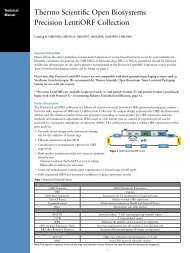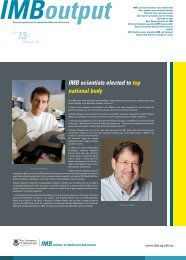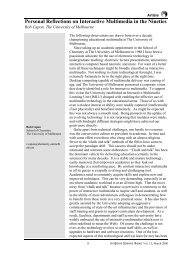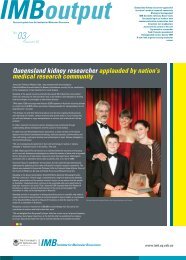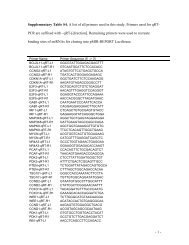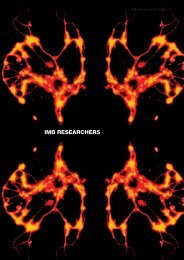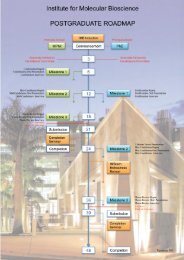2010 Annual Report - Institute for Molecular Bioscience - University ...
2010 Annual Report - Institute for Molecular Bioscience - University ...
2010 Annual Report - Institute for Molecular Bioscience - University ...
Create successful ePaper yourself
Turn your PDF publications into a flip-book with our unique Google optimized e-Paper software.
49 imb researchers: molecular cell biology<br />
ALPHA YAP<br />
CADHERIN ADHESION AND TISSUE ORGANISATION<br />
IN HEALTH AND DISEASE<br />
actin cytoskeleton, thereby influencing cell<br />
shape, adhesion, and cell-cell cohesion.<br />
Relevant signals include the Rho family<br />
GTPases and Src family kinases. These<br />
affect a range of cytoskeletal regulators,<br />
including actin nucleators, cross-linking<br />
proteins, scaffolds and the myosins II and<br />
VI. We aim to understand the dynamic<br />
spatial and temporal regulation of the<br />
cytoskeleton by cadherin signalling, with<br />
a view to understanding how these key<br />
elements are used during development<br />
and tissue maintenance, and how they are<br />
disrupted in human disease.<br />
CELLS ARE THE BUILDING BLOCKS<br />
of our bodies. Interactions between<br />
different cells are important to shape<br />
our developing bodies and maintain the<br />
organisation of our tissues in health. A<br />
range of diseases occur when those<br />
interactions are disturbed, including<br />
cancer and inflammation. My laboratory<br />
studies one set of cell-to-cell interactions,<br />
those that occur when cells attach to one<br />
another. We focus on the cadherin family<br />
of cell-cell adhesion receptors. These<br />
critically determine the ability of cells<br />
to recognise one another and organise<br />
into coherent tissues. The importance of<br />
these receptors is emphasised by the fact<br />
that loss of cadherin function promotes<br />
cancer progression in epithelial tissues<br />
(such as the breast and colon) – the<br />
commonest <strong>for</strong>m of human cancers.<br />
Cadherin dysfunction also contributes to<br />
the breakdown of epithelial barriers during<br />
inflammation, notably in chronic disease<br />
of the intestine. By understanding the<br />
basic biological mechanisms of cadherinmediated<br />
cell recognition, we thus hope<br />
to provide vital insights into the basis of<br />
developmental patterning and common<br />
human diseases.<br />
Currently we focus on understanding<br />
how cadherins cooperate with the actin<br />
cytoskeleton, long believed to be central to<br />
cadherin function. Our experience makes<br />
it increasingly clear that this cooperation<br />
involves a complex interplay between<br />
adhesion receptors and diverse distinct<br />
states of the cytoskeleton, coordinated<br />
by a variety of signalling pathways at the<br />
cell membrane. In particular, our work<br />
demonstrates that cadherins function as<br />
adhesion-activated cell signalling receptors<br />
that stimulate pathways to regulate the<br />
An important challenge we are beginning<br />
to confront is how to understand the<br />
complexity of cytoskeletal regulation<br />
at cell-cell junctions. Our research<br />
experience, accrued over the past several<br />
years, indicates that multiple cytoskeletal<br />
regulators are coordinated at cadherin<br />
adhesion to control junctional dynamics,<br />
homeostasis and integrity. How then do we<br />
develop a coherent model to encompass<br />
this complex system A significant<br />
breakthrough is our recent discovery,<br />
published in Nature Cell Biology (Smutny<br />
et al., <strong>2010</strong>), that these cell signals and<br />
effectors function in modules, where key<br />
effectors are subject to specific signal<br />
regulation and have distinct cellular<br />
functions, that synergise to support<br />
junction integrity. This work was the subject<br />
of an editorial review in Nature Cell Biology<br />
and highlighted on Faculty of 1000. We<br />
are now working with Dr Nick Hamilton to<br />
develop mathematical tools to measure<br />
and model these complex systems.<br />
RESEARCH PROJECTS<br />
• Regulation of the actin cytoskeleton by<br />
E-cadherin<br />
• Cooperation between cadherins and<br />
myosin motors at cell-cell contacts<br />
• Cooperativity between cadherins and<br />
microtubules<br />
• Cadherin signalling to Src family kinases:<br />
defining the pathway(s)<br />
• The morphogenetic consequences of<br />
cadherin-activated cell signalling and<br />
cooperativity with the actin cytoskeleton<br />
KEY PUBLICATIONS<br />
Smutny, M., Cox, H.L., Leerberg, J.,<br />
Kovacs, E.M., Conti, M.A., Ferguson, C.,<br />
Hamilton, N.A., Parton, R.G., Adelstein,<br />
R.S., and Yap, A.S. (<strong>2010</strong>). Myosin<br />
II iso<strong>for</strong>ms identify distinct functional<br />
modules that support integrity of the<br />
epithelial zonula adherens. Nature Cell<br />
Biology 12: 696-702.<br />
Den Elzen, N., Buttery, C.V., Maddugoda * ,<br />
M.P., Ren * , G., and Yap, A.S. (2009).<br />
Cadherin adhesion receptors orient the<br />
mitotic spindle during symmetric cell<br />
division in mammalian epithelia. <strong>Molecular</strong><br />
Biology of the Cell 20: 3740-3750. ( * Equal<br />
contributions)<br />
Ren, G * ., Helwani * , F.M., Verma * , S.,<br />
McLachlan, R.W., Weed, S.A., and Yap,<br />
A.S. (2009). Cortactin is a functional target<br />
of E-cadherin-activated Src family kinases<br />
in MCF-7 epithelial monolayers. Journal<br />
of Biological Chemistry 284: 18913-<br />
18922. ( * Equal contributions)<br />
Akhmanova, A. and Yap, A.S. (2008).<br />
Organizing junctions at the cell-cell<br />
interface. Cell 135: 791-793.<br />
LAB MEMBERS<br />
Senior Research Officer: Dr Eva Kovacs<br />
Research Officers: Dr Guillermo<br />
Gomez, Dr Michael Smutny, Dr Aparna<br />
Ratheesh, Dr Robert McLachlan, Dr Karen<br />
Chambers, Dr Siew Ping Han<br />
Research Assistants: Suzie Verma, Kris<br />
Blucher<br />
PhD Students: Sabine Mangold, Joanne<br />
Leerberg, Vincent Leong, Selwin Wu




